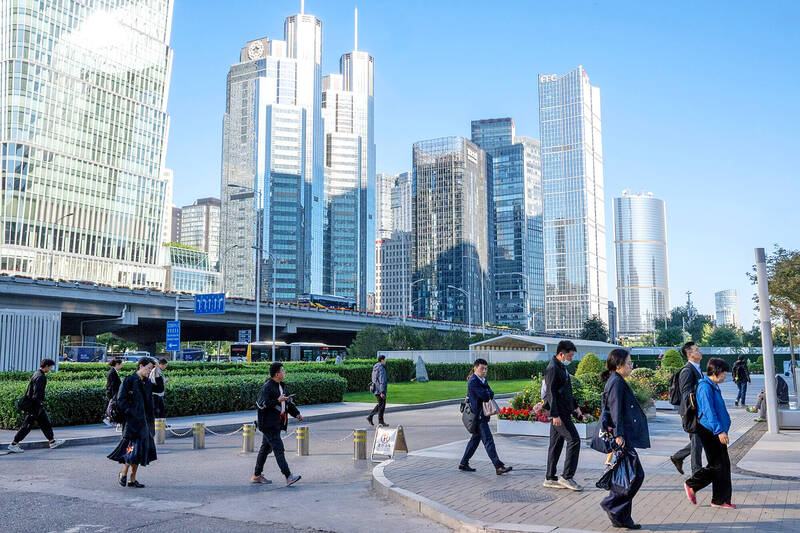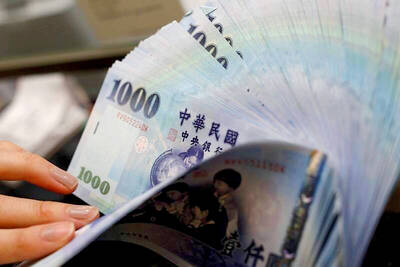China’s economic planning agency yesterday outlined details of measures aimed at boosting the economy, but refrained from major spending initiatives.
The piecemeal nature of the plans announced yesterday appeared to disappoint investors who were hoping for bolder moves, and the Shanghai Composite Index gave up a 10 percent initial gain as markets reopened after a weeklong holiday to end 4.59 percent higher, while Hong Kong’s Hang Seng Index dived 9.41 percent.
Chinese National Development and Reform Commission Chairman Zheng Shanjie (鄭珊潔) said the government would frontload 100 billion yuan (US$14.2 billion) in spending from the government’s budget for next year in addition to another 100 billion yuan for construction projects.

Photo: Bloomberg
The scale of spending overall was well below the multitrillion yuan levels that analysts said might be expected.
Zheng said China was still on track to attain its full-year economic growth target of about 5 percent, but he acknowledged the economy faces difficulties and an increasingly “more complex and extreme” global environment.
In a note, UBS chief China economist Wang Tao (王濤) said that the market was “likely expecting a significant fiscal stimulus.”
A modest package of 1.5 trillion to 2 trillion yuan is more reasonable to expect in the near term, she said, with another 2 trillion to 3 trillion yuan next year.
Late last month, China unveiled a monetary stimulus package including cuts to mortgage rates and in the amount of reserves required to keep on deposit with the central bank.
Those and other measures were the most aggressive efforts so far to try to pull the property industry out of the doldrums and spur faster growth.
The commission said the new measures would focus on boosting investment and spending, and supporting small and medium-sized businesses that operate at a disadvantage to large, state-corporations.
However, much of the information focused on technical issues, such as payment regulations, management of projects and deployment of bonds for financing.
Separately, Chinese drinkers might have to pay more for Remy Martin and other European brandies after the government yesterday announced provisional tariffs of 30.6 to 39 percent on those liquors, four days after most EU countries approved duties on China-made electric vehicles (EVs).
The tit-for-tat move potentially gives Chinese negotiators leverage in talks with the EU on reducing or eliminating the tariffs of up to 35.3 percent on Chinese EVs, which take effect at the end of this month.
The brandy tariffs are provisional and require importers to make a deposit with the Chinese customs for the amount of the tariff, starting on Friday.
The announcement followed a preliminary finding by the Chinese Ministry of Commerce in late August that European brandy was being dumped in China, threatening “substantial damage” to domestic producers.
The brandy probe mainly targeted French makers of Cognac and similar spirits such as Armagnac. France has supported the investigation into Chinese-made EVs, while Germany, whose automakers fear retaliation in the Chinese market, has opposed it.
The provisional tariffs vary by brand, similar to the EU duties on EVs made in China. For example, Martell products face a 30.6 percent tariff versus 38.1 percent for Remy Martin and 39 percent for Hennessey.
The tariffs are being imposed on dozens of companies, including some Spanish producers.

Merida Industry Co (美利達) has seen signs of recovery in the US and European markets this year, as customers are gradually depleting their inventories, the bicycle maker told shareholders yesterday. Given robust growth in new orders at its Taiwanese factory, coupled with its subsidiaries’ improving performance, Merida said it remains confident about the bicycle market’s prospects and expects steady growth in its core business this year. CAUTION ON CHINA However, the company must handle the Chinese market with great caution, as sales of road bikes there have declined significantly, affecting its revenue and profitability, Merida said in a statement, adding that it would

Greek tourism student Katerina quit within a month of starting work at a five-star hotel in Halkidiki, one of the country’s top destinations, because she said conditions were so dire. Beyond the bad pay, the 22-year-old said that her working and living conditions were “miserable and unacceptable.” Millions holiday in Greece every year, but its vital tourism industry is finding it harder and harder to recruit Greeks to look after them. “I was asked to work in any department of the hotel where there was a need, from service to cleaning,” said Katerina, a tourism and marketing student, who would

i Gasoline and diesel prices at fuel stations are this week to rise NT$0.1 per liter, as tensions in the Middle East pushed crude oil prices higher last week, CPC Corp, Taiwan (台灣中油) and Formosa Petrochemical Corp (台塑石化) said yesterday. International crude oil prices last week rose for the third consecutive week due to an escalating conflict between Israel and Iran, as the market is concerned that the situation in the Middle East might affect crude oil supply, CPC and Formosa said in separate statements. Front-month Brent crude oil futures — the international oil benchmark — rose 3.75 percent to settle at US$77.01

RISING: Strong exports, and life insurance companies’ efforts to manage currency risks indicates the NT dollar would eventually pass the 29 level, an expert said The New Taiwan dollar yesterday rallied to its strongest in three years amid inflows to the nation’s stock market and broad-based weakness in the US dollar. Exporter sales of the US currency and a repatriation of funds from local asset managers also played a role, said two traders, who asked not to be identified as they were not authorized to speak publicly. State-owned banks were seen buying the greenback yesterday, but only at a moderate scale, the traders said. The local currency gained 0.77 percent, outperforming almost all of its Asian peers, to close at NT$29.165 per US dollar in Taipei trading yesterday. The